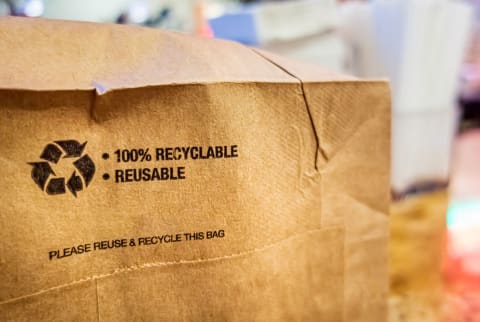Advertisement
The Problem With Recycling + How A New California Law Might Help


When you see the recycling symbol on a product, does it make you feel better about buying it? Unfortunately, the three arrows don't mean that all recycling bins accept that item or even that the item will be recycled when you put it in the proper bin.
Confusing, huh? Let's dive into what recyclable packaging claims are, what they aren't, and where they're heading.
Current recycling claims tell you about whether an item can be collected by a recycler.
Historically, the recycling symbol has told us if recyclers accept a certain material. The Federal Trade Commission's Green Guides1 (which are guides, not laws, mind you) say a package shouldn't sport the word "recyclable" or the chasing arrows symbol unless 60% of consumers in the U.S. can access a blue bin that accepts it.
This seems reasonable, right? At least on the surface. But it's not so simple because the types of waste accepted by recyclers vary from location to location. Whether or not your municipal recycling service accepts a type of waste depends on whether or not they can profit from recycling it.
Most only accept aluminum cans, paper/cardboard, glass, and plastics #1 and #2. If your recycler accepts plastics number #1 through #7, they are probably only sorting out and recycling the #1, #2, and potentially #5 plastics, and disposing of the rest. You can be especially confident they're not recycling #7 plastics, as it's the "other" category (basically a catchall for plastics that don't fit in categories 1 through 6).
Even if your local recycling company accepts a certain type of waste, they won't always recycle it after collection. This doesn't mean they're evil or intentionally misleading: Ultimately, they're not legally required to recycle anything they collect.
Even in countries renowned for their recycling systems, things aren't as straightforward as they seem. Germany is often lauded for its 65% recycling rate, the best in the world. But more than 60% of German "recycling"' is actually incinerated—25 million tons of waste in 2019—and a portion of the remaining percent is exported to other, often poorer, countries.
That's why we've been seeing headlines like, "A whopping 91 percent of plastic isn't recycled" and "Recycling in the U.S. is broken." Now, these articles exaggerate the reality, but there's a kernel of truth to them.
New standards require actual recycling to claim recyclable.
For an item to be practically recyclable, there are three things that need to happen: There needs to be a process in place for recycling the item; the item needs to be collected; and the item needs to be processed into something new (which depends on available infrastructure and favorable economics). As the Ellen MacArthur Foundation puts it, "A packaging or packaging component is recyclable if its successful post-consumer collection, sorting, and recycling is proven to work in practice and at scale."
We've already seen that just because an item is technically recyclable and collected to be recycled does not actually mean that item will get recycled.
But new, exciting legislation is putting forth standards based on practical recycling. Passed in 2021, California state bill 343 calls for "truth in recycling" by regulating the word recyclable and the chasing arrow symbol. SB 343 says these can only be used on materials that are accepted in curbside bins, can be sorted into defined streams, and can be reclaimed at recycling facilities. Now, "recyclable" no longer means "collected in over 60% of recycling bins" but "actually will get recycled" in California.
Once SB 343 begins to be enforced on January 1, 2024, many companies that currently put the recycling symbol on their products or packages will have to stop. As the founder of a company that processes hard-to-recycle materials, I think this type of regulation is much-needed and believe it will likely be picked up by other states (rendering it a de facto national standard) as well as other countries.
Compostable standards are further behind.
The "compostable" claim is not yet in the legislative crosshairs the way the "recyclable" claim is.
In the U.S., there is no federal legislation around compostable and biodegradable claims. Again, the FTC offers guidelines in its Green Guides, but no laws. Only a handful of states legislate the term (and only the claim, not the actual composting of the item). The laws in these states require packaging to meet American Society for Testing and Materials (ASTM) standards D6400 and/or D6868, which say that in order for a plastic to be labeled as commercially "compostable," it must be able to be broken down at a commercial or industrial composting facility.
In other words, the claim "compostable" only focuses on the technical capacity for that item to degrade in proper conditions. Unlike with the claim "recyclable," there's no required access to infrastructure. (At this time, only 3% of Americans have access to municipally run curbside composting, and only a small portion of those facilities accept compostable packaging).
The silver lining is that the legislative progress we're seeing when it comes to making the recyclable claim more truthful will likely shift to the compostable claim soon.
What can you do?
When consumers don't see a problem, we don't know to put pressure on companies and legislators to make change. We've now begun to see the problem with recycling claims, and as a result, change is coming.
We also have a responsibility when it comes to what we consume and throw out. Reduce, reuse, and recycle are listed in that order for a reason. Recycling is an important part of solving the waste crisis, but it's not the answer. And as far as compostables, don't view them as a better alternative than recyclables, unless they're the type you can throw on your home compost pile.
Ultimately, the true solution is to stop waste at the source. We all need to vote for a better future by buying less.